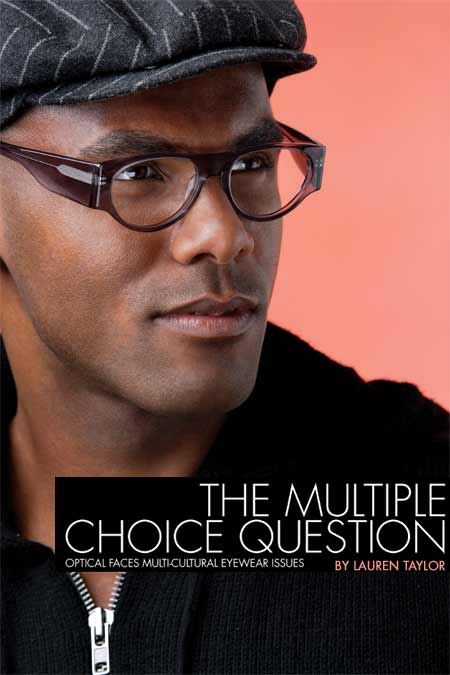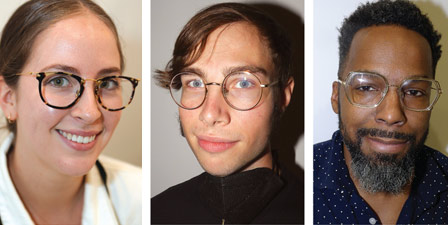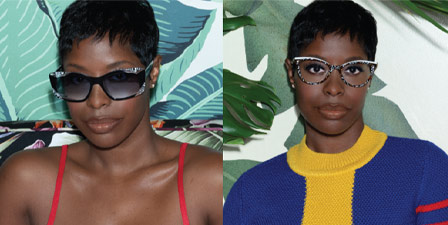
Photographed by Ned Matura
Frame: John Varvatos v732 by Base Curve/A Luxury Division of Rem Eyewear
Size matters. Big or small, short or tall, everybody—and every body—is different. Clothing companies have begun to notice this and respond by featuring “curvy” or “straight” styles. Entire brands have been developed to satisfy general sizing differences faced by specific cultures (think: Apple Bottoms and Thalia fashion lines). Eyewear, however, is generally not offered in a multitude of sizes.
“Just like one shoe size does not fit every foot, one eyeglass frame does not fit every individual. But in the optical industry, we have traditionally tried to make one size fit all,” says Blake Kuwahara, creative director for Base Curve/A Luxury Division of Rem Eyewear.
In the past, this issue was dealt with by customization. “When I first started in this business in the ’70s, glasses were more custom-made,” recalls Edward Beiner, eyewear designer and owner of nine retail stores in Florida. “Frames came disassembled to the optician. The warehouse had rows of different temples, bridges and frame fronts, so the eyewear could be customized for the wearer.”
However, while eyewear used to be considered a medical device, today it’s a fashion accessory and available in seemingly infinite styles and colors. “Now we have all the different styles, but not all the sizes and bridges to cover different markets and ethnic groups,” notes Beiner.
When it comes to fitting eyewear on a particularly challenging face, rimless is an option for many opticians. “The practitioner can freely interchange lens shapes and lens sizes, altering the dimensions of lens sizes for more or less depth,” says Barry Santini, optician and owner of Long Island Opticians in Seaford, N.Y. “You can determine where the bridge should be mounted by taking a bridge piece that fits specifically on the person’s nose, holding it up to the patient’s face with the lens shape and marking where the drill point should go.”
Dr. Robert Chu, a managing optometrist at Eyeworks Group in Fort Worth, Texas, concurs. “Ultimately to fit any patient, the optical industry must shift from the mass-produced ‘one-size-fits-all’ frames of today to creating modular, easily customizable eyewear systems. We carry Lindberg Spirit rimless frames, which are fully customizable from temple lengths to bridge widths to lens shapes and sizes. Most of today’s modern patternless edgers can easily modify lens shapes.”
When fitting heads with shorter-than-average temple requirements, such as Asians and petite women, sometimes it’s better to try an occipital fit instead of one that curves around the ear. “Oakley frames do this well—a straight-temple skull fit that bends the end of the temples inward to provide support,” says Santini. “If I try this fit with a frame not originally designed that way, spring hinges become a handicap. The design requires a clamp-like fit around the head so the spring hinges give way laterally from the pressure of the head.” Sometimes a little cement on the spring hinges keeps them in place, he adds.
Aside from temple fit, Oakley offers other alternative fits. “A growing trend in the industry is the addition of the ‘Asian fit’ nose bridge,” says Dr. Chu. “Oakley now has an Asian fit version for most ophthalmic models. These frames have a smaller, narrower bridge that lifts the frame on the face because many Asians have less pronounced bridges than Caucasians.”
In addition, Rem Eyewear has developed an alternative fit for its John Varvatos line. “With our John Varvatos collection we now offer an Alternative Fit for all Rx and sunglass styles, as well as the standard fit,” says Kuwahara. With the Alternative Fit, we have not created a new bridge design, but rather a new pad arm that has a higher pad height (11mm or 11.5mm) instead of the standard 9mm and have also changed the inclination of the angle by adding an additional bevel. The result is improved fit, but no change in the silhouette of the frame. Additionally, because the pad arm is crystal, it blends in with the design.”
Plastic frames are the hot trend right now, but plastic is often not forgiving when it comes to altering the fit. Typically, the temples can’t be bent and the nosepads are stationary. But minor adjustments are possible. “We use adjustable nosepads on every metal frame and also use adjustable nosepads in our zyls in the Vera Wang collection,” says Jason Wehlage, product designer for Kenmark Group.
With its Republica collection, Kenmark addresses the needs of guys with large heads from all over the world, says Wehlage. “We offer eye sizes that extend from 50mm to 62mm and temple lengths up to 150mm. We use model heads in our design area: a standard American head, European head (a little more slender) and Asian head (a little wider) and then try the frames on the various heads to see what works.”
Another company known for larger men’s sizes is A&A Optical. “Dispensaries need product that satisfies diverse fitting needs. When designing our XXL collection for men, we did a lot of fine tuning,” says Rodney Hayes, A&A executive vice president. “With this collection we don’t focus on any one culture, but take into consideration the diversity found in a metropolitan area—Caucasians, Hispanics, Native Americans and Asians.”
When it comes to designing the XXL collection, “bridge size is key,” Hayes emphasizes. “We offer multiple bridge sizes in this collection with adjustable nosepads. With the acetate frames, we offer a blended nasal area: the top is narrow and the bottom is slightly flared because if the look is too extreme, people won’t like it. We are careful not to create an obvious open cavity between the top and bottom of the nose area.”
“There are a lot of issues to be addressed in fit; we can’t just blow up the eye shape,” adds Marc Rothstein, consultant for A&A Optical. “Someone, for example, might have a big head, but a small PD. So features like bowed temples and wider endpieces help provide a more customized fit. Or someone might be able to wear a standard eye size, but needs longer temple lengths.”
“We have frame sizes ranging from 36mm to 62mm with temple lengths from 125mm to 145mm and carry such collections as Bulgari, Sean John, Armani and Yves Saint Laurent that go up to a 56mm frame front,” says Hanoi Borjas, optician at Optica Express in New York. When customers want these frames, Borjas does her best to ensure a good fit. “I have them try on the frame, observe how they wear it and make adjustments. But if it doesn’t fit after multiple adjustments, I’ll be honest and recommend a different frame,” she notes.
When working with zyl frames, Santini recommends cold inserts for petite women because the frames don’t stretch and won’t start to slide down their face too quickly. “I typically recommend metal frames so I can adjust the nosepads, but that’s getting harder as fashion trends toward plastics.”
Borjas suggest Flexon metal frames because the nose is adjustable and they wrap around the head, but give a little bit of space on the side.
An advantage of plastic, however, is it allows for color choices that complement any skin type. “It’s necessary to have options with frame colors, too,” says Hayes. “We try frames of various colors on staff members to see how different tones work on differing complexions.”
When fitting eyewear, it’s important to refrain from stereotyping, Borjas explains. “I definitely treat all my customers equally. People tend to want the same things because they see the same brands on celebrities and in magazines.”
Wehlage agrees. “Republica has been evolving both with its clothes and eyewear. Originally it was more of a ‘street look.’ Now it’s more of a tailored fashion look and less ostentatious. In general, I think there’s less separation between what various groups want. People want their own distinctive perspective, but they don’t want to be too different.”
Hayes adds, “We are careful to avoid stereotyping. Styles in eyewear and clothes are much more of a blending of various cultures now than in the past. Our society is increasingly becoming a blended society. Products we offer should reflect that blending.”
Although more companies are taking a diverse approach to their eyewear, there’s definitely room for improvement. As eyewear continues to grow as a fashion accessory, customers will begin to expect better fit options in their frames just as they do with their clothes.
“There are 40 million African-Americans and 13 million Asians in America,” says Beiner. “Those markets need to be addressed.”













